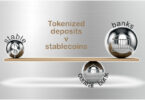Yesterday Uchina Shinichi, Executive Director of the Bank of Japan, spoke about the central bank’s work on a retail central bank digital currency (CBDC).
Three key takeaways include:
- A decision to issue a CBDC is not up to the central bank but the people of Japan.
- A key motivation for a CBDC issuance would be to head off the potential widespread adoption of Yen stablecoins.
- Phase 2 CBDC trials plan to explore aggregating CBDC balances that have been distributed via multiple intermediaries.
A digital yen referendum?
In his speech to the Coordination Committee on Central Bank Digital Currency, Mr. Uchida stated, “The decision as to whether or not a CBDC should be issued cannot be made by the Bank nor by the financial sector alone. It will have to be a judgement by the Japanese people.”
Now that could mean that Japan intends to have a referendum on the Digital Yen. Or it could be an issue of translation and the difference between issuance versus adoption. However, the English translation was the official Bank of Japan version.
CBDC motivations: The dangers of stablecoins
The Bank of Japan’s concerns about stablecoins are not the same as those articulated by other central banks, which often focus on the fragility and potential instability of stablecoins.
Japan views stablecoin payments as inherently unprofitable. And hence the primary concern is what stablecoin issuers will do to make money. While others have raised this issue, this was Mr. Uchinda’s key point.
A stablecoin issuer is likely to offer adverts, sell user data, and try to lock in customers. The result could be market fragmentation and market dominance.
Sweden’s SWISH mobile payment platform is one answer to share the cost of unprofitable payments amongst private players. And a CBDC is another avenue. Ironically, Sweden’s central bank doesn’t seem entirely comfortable with the dominance of SWISH.
What wasn’t mentioned is a timing issue. In the absence of a CBDC, individual organizations might aim to become the dominant stablecoin player.
Also not referenced was the private Japanese initiative with many of Japan’s biggest banks and private companies exploring bank-issued Yen digital currencies, the Digital Currency Forum. It plans to commercialize the solution next year.
Phase 2 digital yen trials
The second round of digital yen trials that recently started will test distributing a CBDC via multiple intermediaries. But more than that, it will explore aggregating the CBDC received via different sources. The rationale is that if one intermediary’s platform is down, you should still be able to use the CBDC.
That’s also necessary to enforce any limits on transactions or balances that may be desirable to protect the banking system. Japan does not plan for a CBDC to earn interest or impose negative interest rates. It was also noted that a negative interest CBDC is “operationally unrealistic while cash still exists.”
Finally, the Bank of Japan wants to ensure that any potential CBDC isn’t too unique and is consistent with global standards.
That’s likely partly because CBDCs are viewed as a route to reducing the cost of cross border payments. Although currently cross border CBDC trials are for wholesale CBDCs, including the M-CBDC Bridge Project (MBridge), Project Dunbar and Project Jura.






